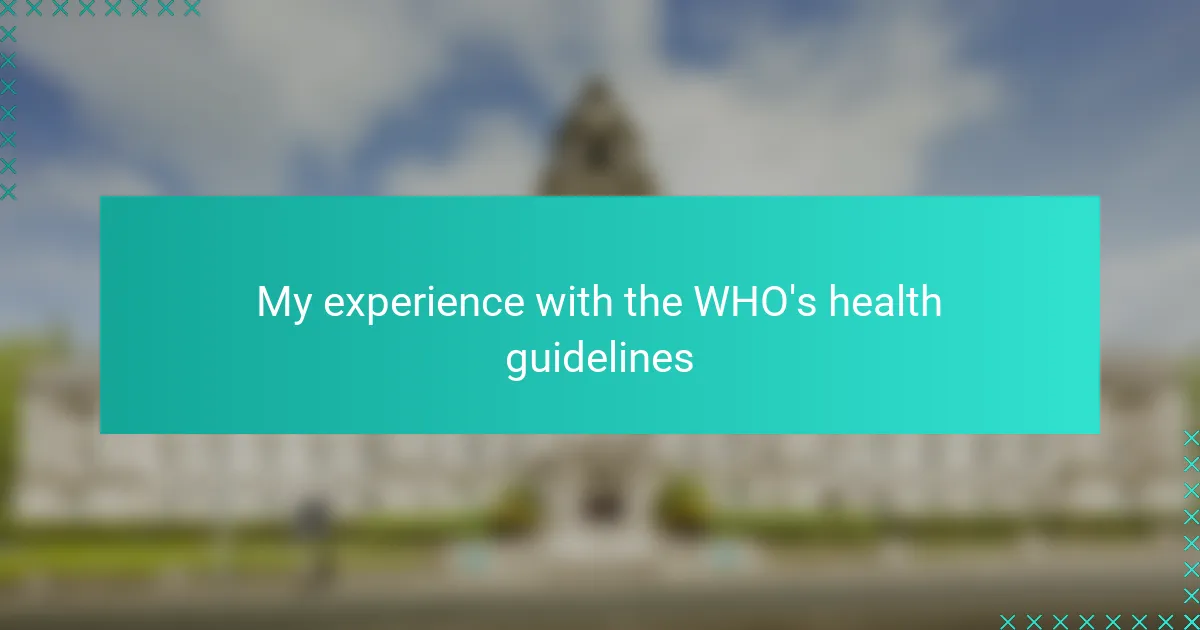Key takeaways
- WHO guidelines aim to balance evidence-based research with practical application, but their effectiveness can vary across different cultural and resource contexts.
- Adaptability and transparency of WHO guidelines are vital, as frequent updates can create confusion yet reflect commitment to improving public health.
- Effective compliance requires local adaptation of guidelines, clear communication to build trust, and innovative solutions to resource limitations.
- The intersection of health guidelines and global politics can significantly influence national policies and international relations during health crises.
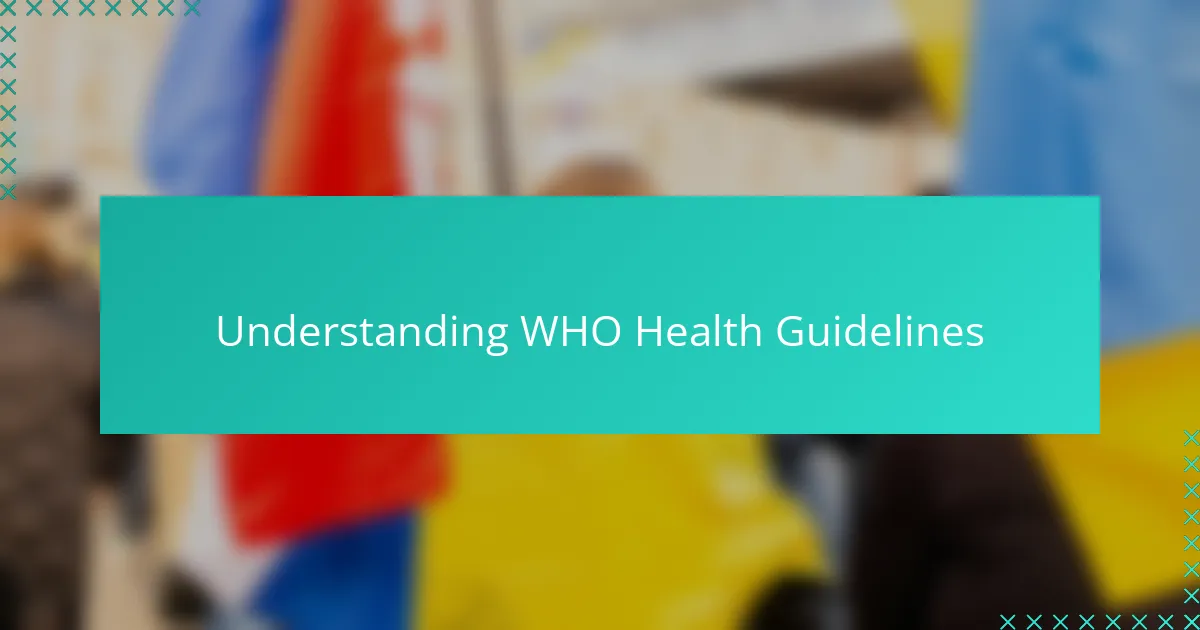
Understanding WHO Health Guidelines
Understanding WHO health guidelines, in my experience, has been both enlightening and at times frustrating. These guidelines are designed to provide a scientific basis for health policies worldwide, yet interpreting them can feel like decoding a complex puzzle. Have you ever wondered how a single recommendation manages to influence diverse populations with different health infrastructures?
From my perspective, the WHO aims to balance evidence-based research with practical application, but that balance isn’t always perfect. I recall feeling overwhelmed when first trying to apply their guidelines during a public health project, realizing that what works in one country might not fit another’s context. This made me appreciate the nuanced approach the WHO takes—acknowledging global diversity yet striving for universal standards.
What struck me most is the transparency and frequent updates in the WHO guidelines, reflecting new scientific findings and real-world data. This adaptability often reassures me that the organization is committed to evolving and improving public health recommendations, even if it means changing course and facing criticism. Isn’t that flexibility essential in dealing with something as unpredictable as global health?
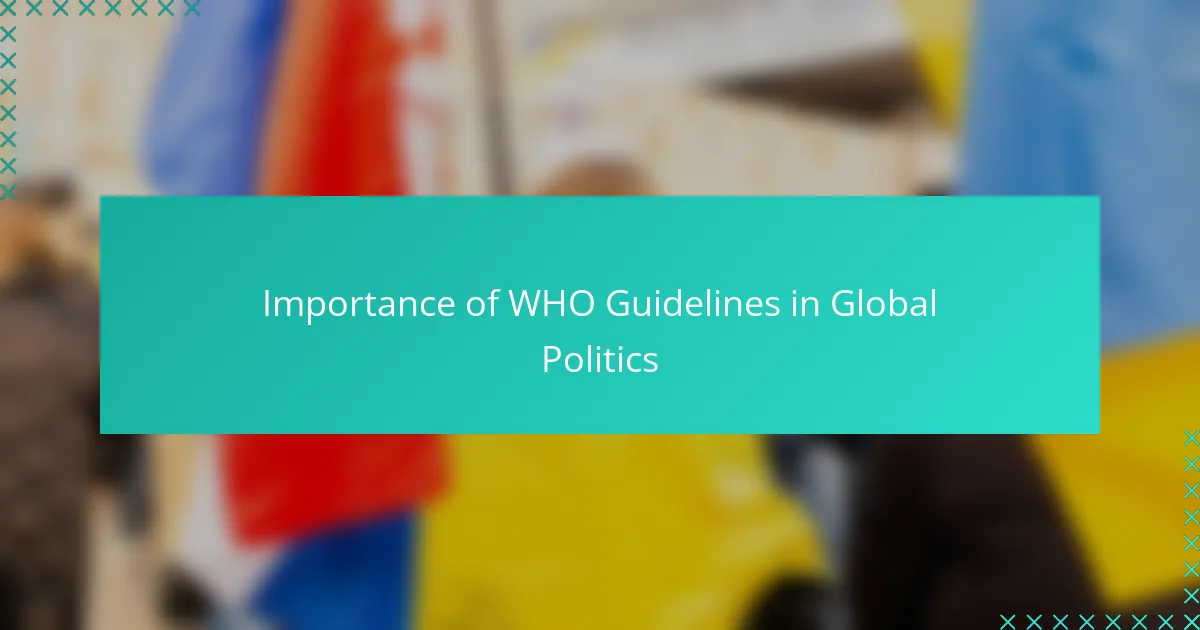
Importance of WHO Guidelines in Global Politics
The importance of WHO guidelines in global politics cannot be overstated. From my experience, these guidelines often become a diplomatic tool, shaping how countries coordinate on health crises—like during pandemics—forcing political leaders to navigate between scientific advice and national interests. Have you noticed how a single recommendation can either unite nations or spark debates over sovereignty and policy priorities?
One moment that stood out to me was observing how some governments strategically aligned with WHO guidelines to bolster their international legitimacy, while others pushed back, citing local context. It made me reflect on the delicate dance between global health governance and political agendas—where health advice is never just about medicine, but also about power and influence.
This interplay between health directives and geopolitics highlights why WHO guidelines hold such significance beyond hospitals and clinics. They act as a framework that can either promote global solidarity or accentuate divisions, depending on how political actors interpret and implement them. Isn’t it fascinating how health recommendations ripple through the corridors of global power?
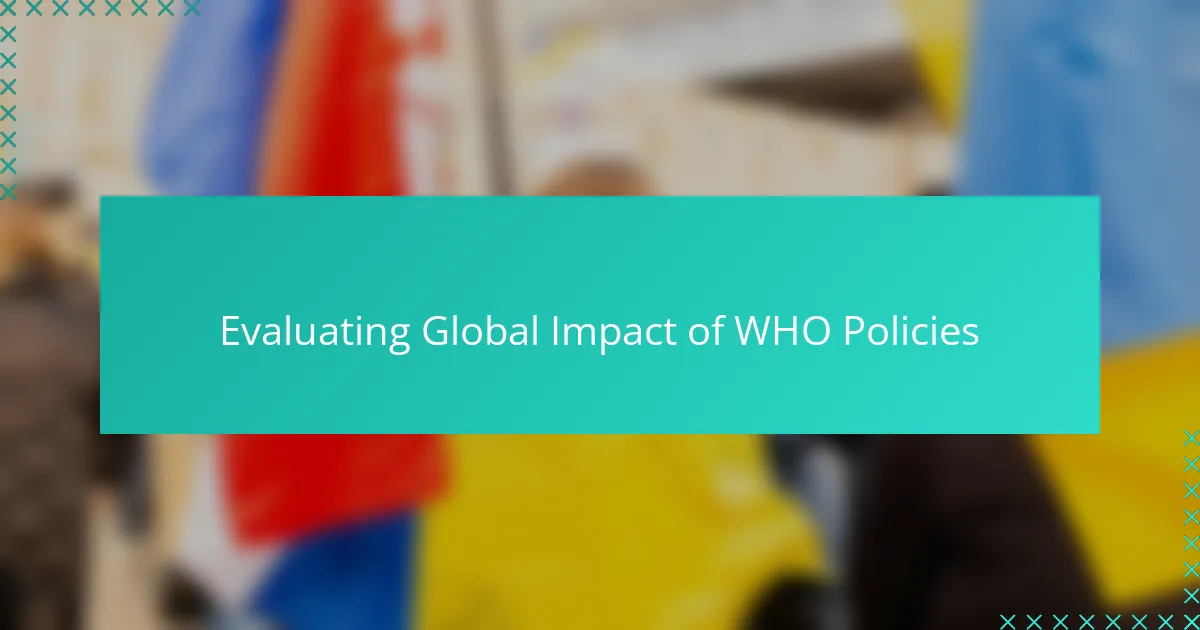
Evaluating Global Impact of WHO Policies
Evaluating the global impact of WHO policies, I find, is a complex but necessary exercise. In my work, I’ve seen how these policies can drive significant change—reducing disease outbreaks in some regions—yet sometimes fall short where local realities clash with global standards. Have you ever questioned whether one-size-fits-all health mandates truly serve the diverse tapestry of our world?
From my observations, the strength of WHO policies lies in their ability to mobilize resources and attention on health crises, often sparking international cooperation I wouldn’t have expected. Yet, I’ve also witnessed moments when rigid adherence to guidelines led to unintended consequences, like delays in localized responses. This tension between uniformity and flexibility is something I continually grapple with in my analyses.
What intrigues me most is how these policies ripple through global institutions and local communities alike, shaping not only health outcomes but also diplomatic relations. In thinking about this, I wonder: can WHO guidelines evolve fast enough to keep pace with the political and social complexities they inevitably encounter? From what I’ve seen, that challenge is as critical as any scientific breakthrough.
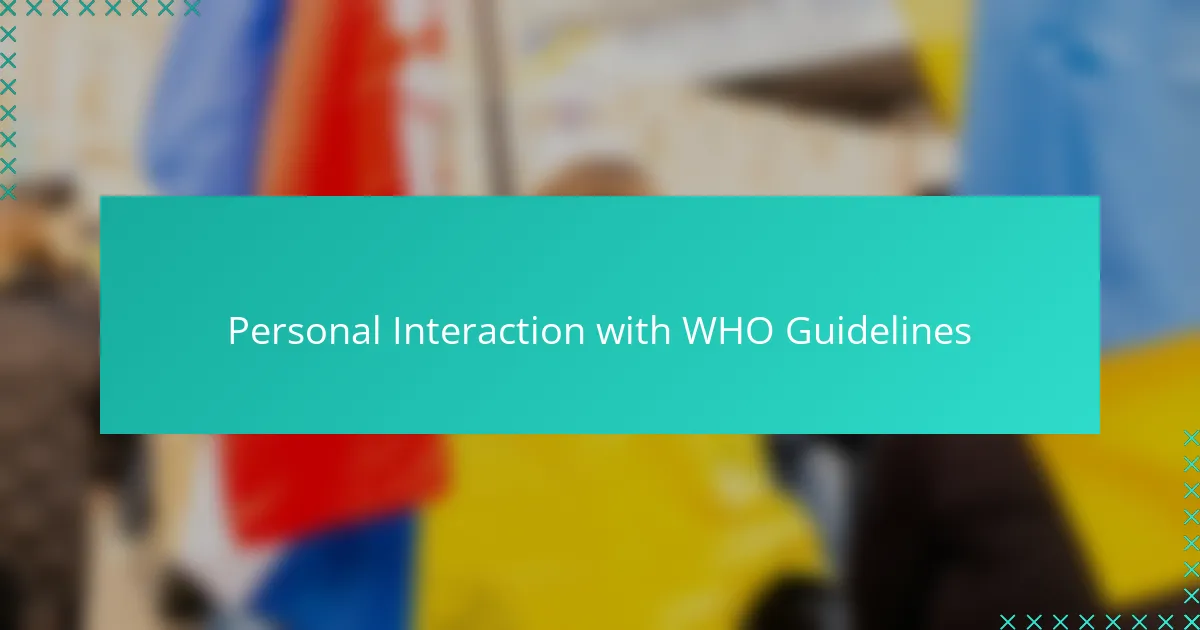
Personal Interaction with WHO Guidelines
When I first tried following WHO health guidelines during a community outreach, I was surprised by how detailed and data-driven they were. Yet, I found myself questioning how to translate those global standards into practical steps for people with limited resources. Have you ever faced that gap between ideal recommendations and on-the-ground realities?
One vivid memory I have is struggling to explain mask-wearing protocols that shifted frequently as new evidence emerged. It was frustrating—not just for me but for community members—highlighting how rapidly updated guidance can create confusion despite good intentions. It made me realize just how challenging it is to maintain trust when health advice changes so fast.
Still, engaging directly with WHO guidelines has deepened my respect for the organization’s commitment to transparency and science. I often wonder: how do health workers worldwide keep pace with evolving directives while addressing unique local needs? From what I’ve seen firsthand, this balancing act demands not only knowledge but also patience and empathy.
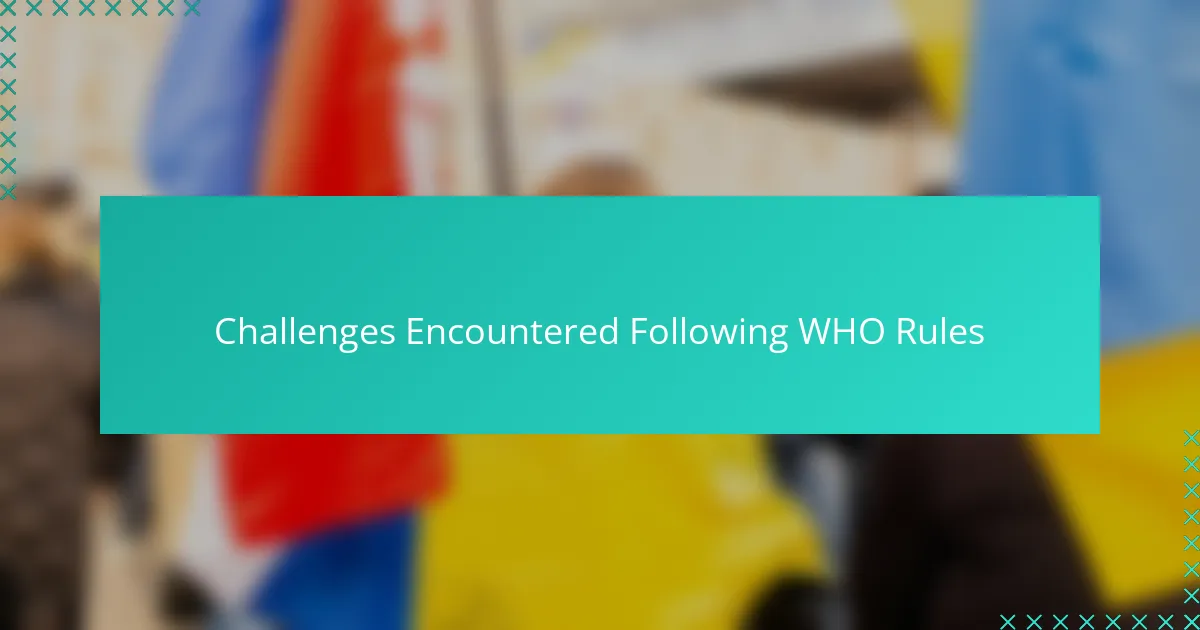
Challenges Encountered Following WHO Rules
Adhering to WHO rules often felt like navigating a maze with shifting walls. I remember once trying to implement quarantine measures that suddenly changed midstream, leaving both staff and community members confused. Have you ever experienced trying to build a plan on foundations that keep moving beneath your feet?
Another challenge I faced was the resource gap—strict hand hygiene protocols sounded ideal, but in settings with scarce clean water, how practical were these directives really? This shortage forced me to rethink how to uphold the spirit of the guidelines without merely ticking boxes, which wasn’t always straightforward.
Additionally, the uniformity of WHO guidelines sometimes overlooked cultural nuances that shaped health behaviors. I found myself asking: how do you persuade a community to adopt measures that clash with deeply rooted traditions? It was an exercise in patience and understanding, reminding me that guidelines are only as effective as their local acceptance.
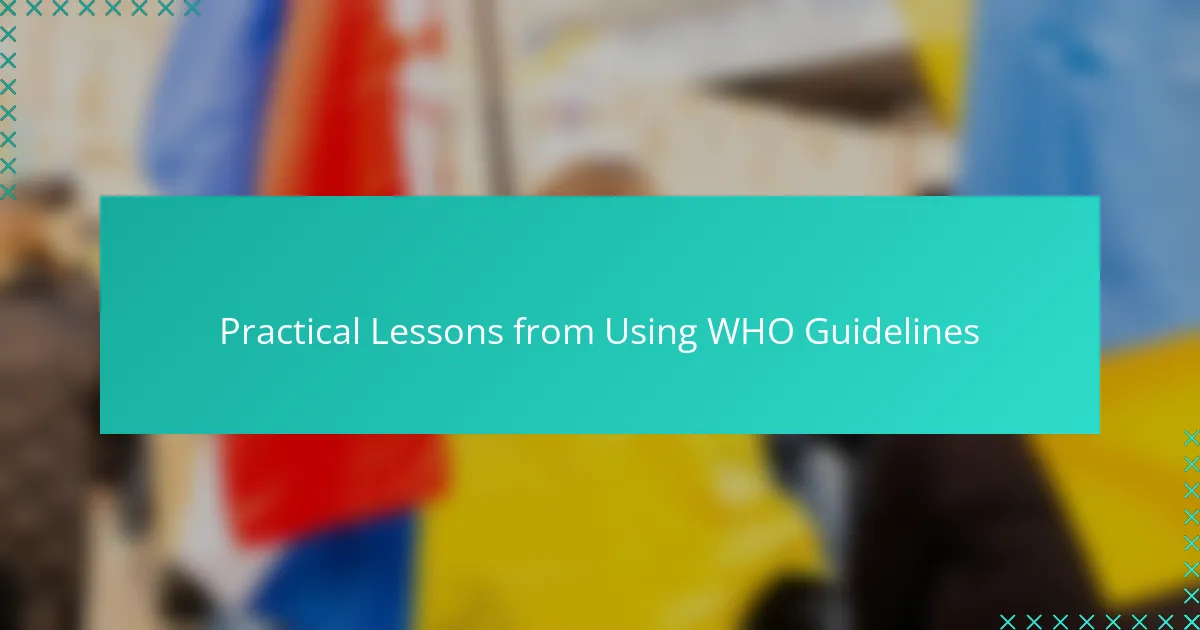
Practical Lessons from Using WHO Guidelines
Navigating the practical side of WHO guidelines taught me that flexibility is key. For instance, when implementing vaccination campaigns, I realized that rigidly following protocols without adapting to local customs could backfire. Have you ever tried to merge global advice with local realities? That balancing act often defines success in public health initiatives.
Another lesson that stuck with me is the importance of clear communication. I recall a time when frequent updates to mask-wearing recommendations caused confusion among community health workers. It made me appreciate how crucial transparency and timely explanations are to maintain trust—especially when science is still evolving.
Lastly, I learned that resource limitations can’t be ignored. Telling communities to wash hands thoroughly when running water is scarce felt disconnected from their everyday challenges. It forced me to think creatively—like promoting alcohol-based sanitizers or other locally feasible alternatives. Isn’t it fascinating how guidelines push us to innovate within constraints?
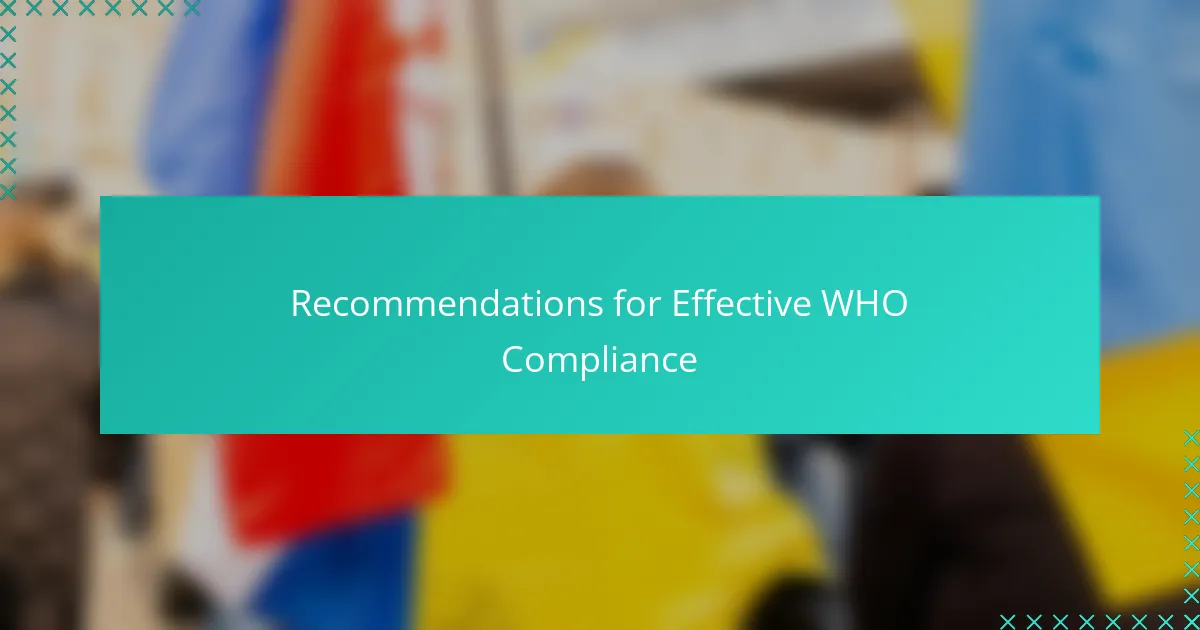
Recommendations for Effective WHO Compliance
To truly comply effectively with WHO guidelines, I’ve found that adapting recommendations to fit local contexts is non-negotiable. Simply transplanting global standards without considering on-the-ground realities can do more harm than good. Have you ever tried following a rule that just didn’t make sense where you live? That disconnect was something I encountered firsthand, teaching me that flexibility and cultural sensitivity are just as critical as the science behind the directives.
Clear and consistent communication also stands out as essential for effective compliance. I remember how frequent shifts in guidance created confusion not just for me but for entire communities—people started doubting the advice because it seemed to keep changing. In my experience, proactively explaining the reasons behind updates and maintaining transparency helps build trust, which in turn fosters better adherence to health measures.
Lastly, dealing with resource limitations taught me to think creatively rather than merely enforcing protocol. For example, advocating for alcohol-based sanitizers when clean water was scarce illustrated how innovation within tight constraints can bridge gaps between ideal recommendations and practical application. Isn’t it encouraging to see how challenges can spur new solutions that respect both guidelines and local realities?
